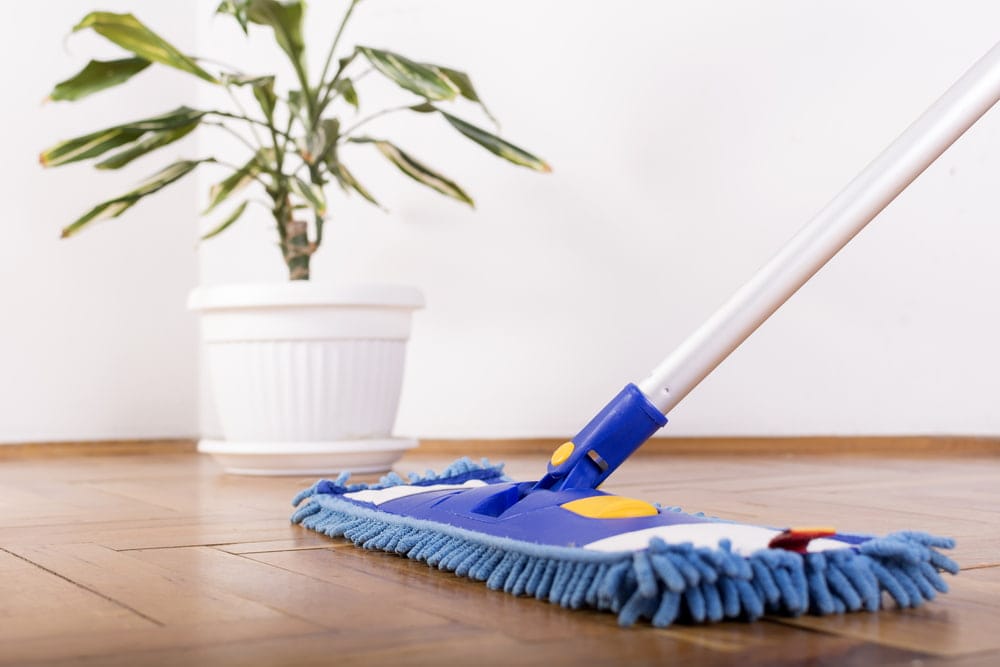Did you know that the way you mop your floor can make a big difference in how often it needs to be cleaned?
When it comes to cleaning floors, mopping is often the best option. It’s quick, efficient, and it gets the job done. Plus, with the right technique and tools, you can make mopping easy and even enjoyable.
So, forget everything you thought you knew about cleaning your floors — it’s time to master the art of mopping.
Types of Mops
The mop you choose can make or break your mopping experience. Generally, there are four types of mops:
String Mop
A string mop is a cleaning tool consisting of a head of absorbent material, such as cotton or synthetic fibres, attached to a handle. The head is typically rectangular, and the strings are connected to one side.
String mops are used to clean floors by wetting the head in water or cleaning solution, then wringing it out and moving it across the floor in a back-and-forth motion.
When the head becomes too dirty, it can be removed and replaced with a new one.
Spin Mop
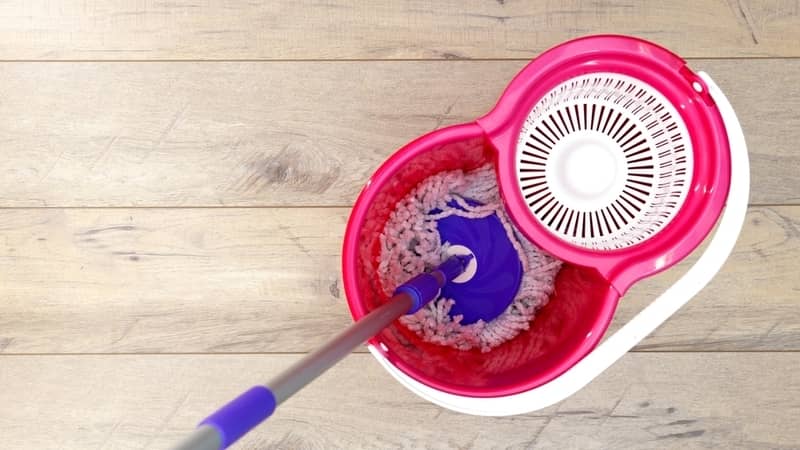
A spin mop is a type of floor mop with a spinning mechanism to wring out the mop head. This allows for much less water to be used when mopping, which can help to prevent soaking and streaking of the floor.
Spin mops are also easier to use than traditional string or flat mops, requiring less physical effort to wring out the mop head.
Spin mops are typically lightweight and easy to manoeuvre, making them ideal for smaller spaces or areas where you need more control while cleaning.
To use the spin mop, dip the head into a bucket of water and then squeeze the handle to rotate the head. This spins the head around, which wrings out any excess water.
Flat Mop
A flat mop has a flat piece of absorbent fabric or sponge attached to a long handle. It cleans floors by dragging the mop head across the surface to absorb dirt, dust, and grime.
While the flat mop is traditionally made from cotton or other natural fibres, modern versions are made from microfibre, which is more effective at trapping dirt and bacteria.
Flat mops are often used with a bucket and wringing mechanism, allowing the user to repeatedly dip the mop head in clean water and wring it out before each stroke.
This ensures that the mop remains damp but not wet, which prevents damage to floor surfaces.
Dust Mop
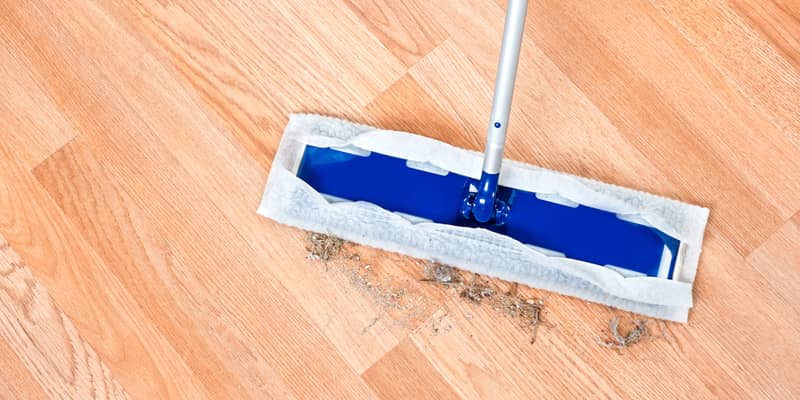
A dust mop is typically made with a cloth or other absorbent material. They are often used with a broom to sweep floors before mopping. Dust mops are used to collect dust, dirt, and debris from floors.
Dust mops are also sometimes used to clean ceilings and walls. When used on ceilings and walls, dust mops are usually equipped with an extension handle to reach high areas.
Not sure which floor mop to choose? Our comprehensive guide will help you find the best mops in Australia.
We’ve compiled a list of the top-rated products on the market, as well as some helpful advice on what to look for when choosing a floor mop.
How to Mop Floors the Right Way
Mopping is not as simple as just running a wet mop over the floor. There is a right way and a wrong way to do it.
Gather Your Supplies
The first step in any successful damp mopping job is making sure you have all the necessary supplies.
You will need:
- A broom and dustpan
- Vacuum (as needed)
- Your chosen mop
- Cleaning solution (depends on your floor type)
- A mop bucket (maybe two — rinse bucket and clean mop bucket)
- A polishing agent if you have hardwood floors
Step-By-Step Guide on How to Mop Floors:
- Start by moving your furniture and removing debris by either sweeping or vacuuming. Regular sweeping also means fewer chances to leave scratches when cleaning your floors.
- Choose your cleaning solution. If you’re using a string mop and bucket, fill the mop bucket with warm water and your chosen solution. If you’re going with a spray mop, remove the spray bottle and fill it with the right cleaning solution.
- Read the directions carefully if you’re using store-bought cleaning products. You can also use white vinegar mixed with warm water if you prefer more natural cleaners. Natural cleaning solutions work well for most types of hardwood or tile floors. For laminate floors, use mild dish soap mixed with warm water.
- Mop strategically and efficiently. Dip your mop in the bucket and wring out the excess water until it’s only slightly damp. Begin mopping in one corner and work your way across the room. Be sure to overlap each stroke, so you don’t miss any spots. You may need to scrub tough or sticky spots to clean them properly.
- Rinse the floor surface. When you finish mopping, rinse your mop head in clean water and wring it out again. Then, run the mop over the floor once more to remove any leftover cleaning solution residue or water.
- Let the floor dry completely before putting the furniture back in place. You can use a clean cloth to wipe it down, but allowing your floor to air dry works just fine.
How to Use a String Mop
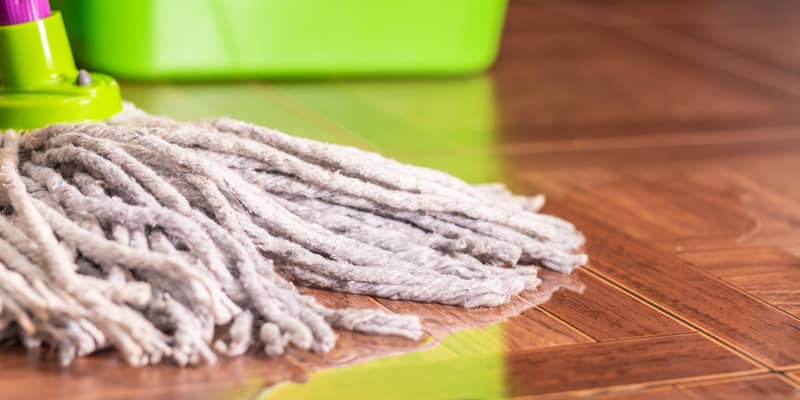
- Fill a clean bucket with warm water and a squirt of dish soap. Then fill another clean bucket with plain water for rinsing.
- Dip the string mop head into the soapy water, then wring it out until it’s damp.
- Slowly move the mop back and forth across the floor, taking care to lift the mop head after each stroke.
- Rinse the mop head in clean water when you’re finished mopping, then wring it out thoroughly.
- Mop over the floor again with clear water to remove any residue from the cleaner.
- Wash the mop head after using it. Then detach it from the handle.
- Hang the mop head up to dry, or place it in a well-ventilated area to air-dry.
- Once the mop head is dry, reattach it to the handle and store it in a cool, dry place.
How to Use a Spin Mop
- Fill the reservoir with water and add your desired amount of cleaner.
- Dip the mop head into the solution and give it a few spins to saturate the head.
- Move the mop over the floor in a back-and-forth motion, being careful not to go over the same area more than once.
- As the mop spins, it will wring out any excess water, leaving only clean water to wash your floors.
- When the head is full, dip it into the reservoir and give it another spin to remove the dirt.
- Repeat this process until the floor is clean.
- Once you’ve finished mopping, disengage the handle and empty the dirty water.
- After mopping, empty the reservoir and rinse the head of the mop in clean water.
- Allow the spin mop to air dry completely before storing it.
How to Use a Flat Mop
- Start by sweeping or vacuuming your floor to remove any large debris.
- Fill a bucket with warm water and your chosen cleaning solution.
- Dip the mop head into the bucket, wring it out, and then begin mopping in small sections.
- Work your way across the floor, rinsing the mop head frequently in the bucket of clean water.
- When you’re done mopping, rinse the floor with fresh water to remove any residue from the cleaning solution.
How to Dust Mop
The key to using a dry mop effectively is to choose the right type of mop head. For example, microfiber mop heads are great for picking up dust, while cotton mop heads are better at absorbing liquid spills.
After selecting the right mop head, attach it to the handle and start mopping in a back-and-forth motion. Be sure to overlap each stroke, so you don’t miss any spots.
When you’re finished, simply detach the mop head and shake it out or wash it.
How Often Should I Mop My Floors?
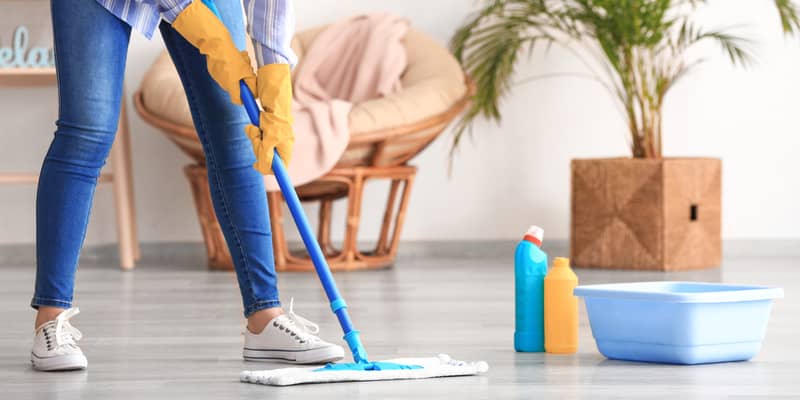
As a general rule, mopping floors once a week is all it takes to keep them looking their best.
Mopping regularly helps to prevent the build-up of dirt and grime, which can eventually lead to scratches and other damage.
In addition, mopping weekly gives you a chance to check for signs of wear and tear, such as loose tiles or creaking boards.
However, you may need to mop more frequently if you have pets or small children. For homes with heavy foot traffic, it’s a good idea to mop at least twice a week.
And if anyone in your household has allergies or asthma, you’ll want to mop even more often to help reduce irritants in the air.
How Often to Mop Laminate Floors
Laminate floors are prone to damage by moisture, so they need to be mopped with care.
Generally, laminate floors should be mopped once a week with a microfibre mop and water-based cleaner.
You may need to mop more frequently for homes with heavy foot traffic or pets.
How to Mop Laminate Flooring
- Sweep the floor with a soft broom or vacuum cleaner with a soft brush attachment. This will remove any dirt, dust, or debris that could scratch the floor when mopping.
- Add a small amount of mild soap to a bucket of warm water.
- Dip the mop head into the solution and wring it out until it is only slightly damp.
- Mop the floor in small sections, using gentle strokes. Avoid scrubbing or using too much pressure, as this could damage the floor.
- After mopping, rinse the floor with a damp cloth to remove any residue.
How Often to Mop Hardwood Floors
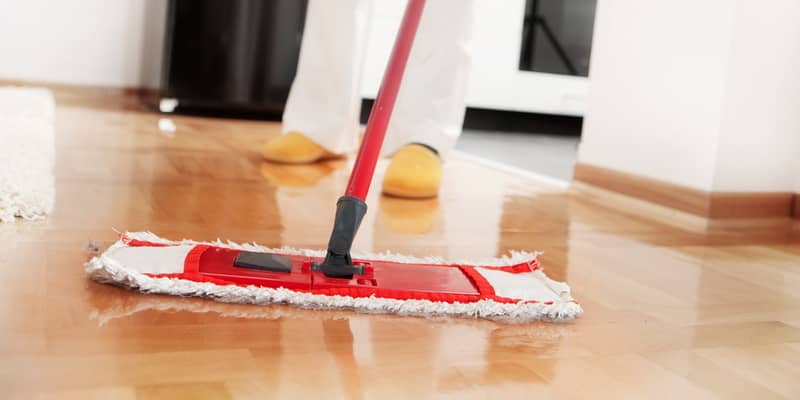
Hardwood floors are classic and elegant, but they require more upkeep than laminate floors.
You need to sweep hardwood floors daily and mop weekly with a gentle cleanser.
You’ll also need to replenish the finish on hardwood floors every few years to keep them looking their best.
How to Mop Hardwood Floors
- Sweep or vacuum the floor to remove any loose dirt or debris. This will help ensure you don’t end up pushing it around with your mop.
- Choose the right type of mop for your floor. A sponge mop or microfiber mop is best for hardwood floors. Avoid using a string mop, as this can leave streaks.
- When it comes to cleaning solutions, less is more. Too much cleaning solution can actually damage hardwood floors by causing them to warp or swell.
- Dilute your cleaning solution with water until it is only slightly damp.
- Mop in small sections, using a back-and-forth motion. Be sure to wring out your mop frequently, so your floor isn’t too wet. Mopping too much can also damage hardwood floors.
- Dry the floor with a clean towel or cloth to prevent water spots. Once the floor is dry, you can put the furniture back in place.
How Often to Mop Tile Floors
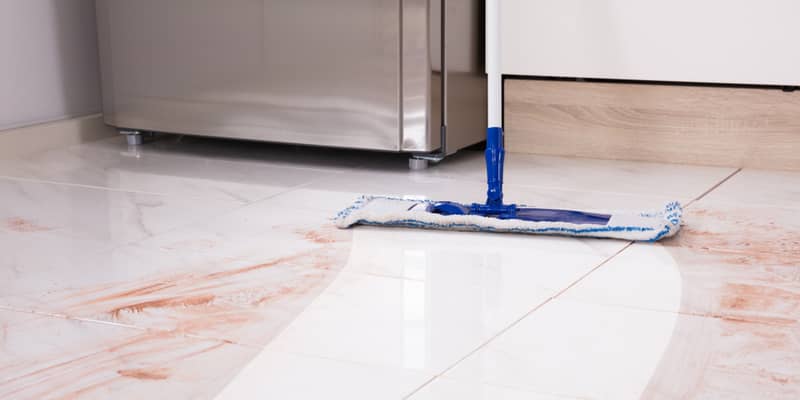
Tile floors are ideal for high-traffic areas because they are very durable and easy to clean.
We recommend sweeping daily and mopping tile floors weekly with a mild soap or cleanser.
To remove stubborn stains, you may need to use a tile-specific cleaner.
Be sure to avoid using too much water when cleaning tile floors, as this can damage the grout between tiles.
How to Mop Tile Floors
- Like all other ways to mop, sweep or vacuum the floor to remove any loose dirt or debris.
- Fill a bucket with warm water and mild detergent. For best results, use a pH-neutral cleaner specifically designed for tile floors.
- Dip your mop into the bucket and wring it out thoroughly before mopping the tile floor in small sections. Be sure to rinse your mop frequently to avoid leaving streaks.
- When you’re finished, allow the floor to air dry or dry it with a clean towel.
How Often to Mop Vinyl Flooring
You should mop your vinyl floor at least once a week. If your floor gets a lot of traffic, then mop twice a week.
The best way to do so is with a damp mop and a mild soap or detergent. Be sure to rinse the mop after each stroke to avoid leaving streaks or spots on the floor.
If you have stubborn dirt or stains, you can use a stronger cleaner, but rinse the floor thoroughly afterwards.
How to Mop Vinyl Floors
- Sweep or vacuum your floor to remove any dirt or debris. Be sure to get into the corners and edges, where dirt and dust can accumulate.
- Wet your mop in clean water. You can add a small amount of mild dish soap to the water if you like, but this is not necessary.
- Wring out your mop so that it is only damp, not wet. Too much water can damage vinyl flooring.
- Mop the floor in small sections, moving back and forth until the entire floor has been mopped. Pay special attention to corners and edges.
- Allow the floor to air dry completely before walking on it or replacing furniture.
Make the Floors so Clean, You Can Eat Off of Them!
Having a clean floor can make a huge difference in the overall appearance of your home, but it’s tough to keep up with the constant mopping and sweeping.
If you’re tired of feeling like your efforts are a never-ending battle, our professional cleaners can help.
Whether you need a weekly, fortnightly, or monthly service, we’ll make sure your floors are always clean.

